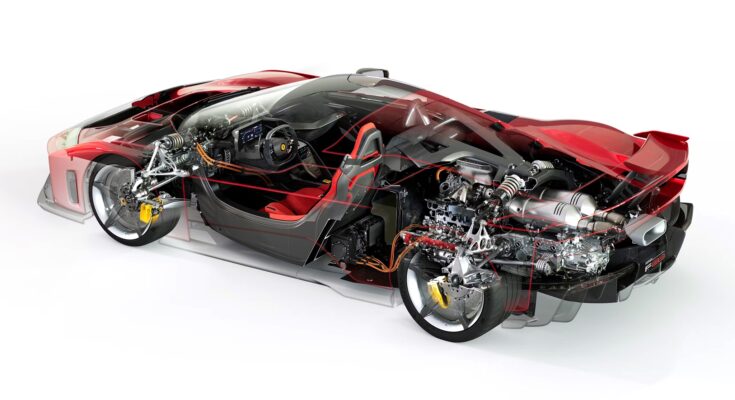The 2026 Ferrari F80 is a technological tour de force built to showcase what the 80-year-old Italian automaker is capable of. Planning began back in 2018 simultaneously with the 499P endurance racer, a car that just won its third consecutive 24 Hours of Le Mans.
AI Quick Summary
The 2026 Ferrari F80 is a tech marvel with a 1,184-hp hybrid powertrain, advanced aerodynamics, and active suspension. It features cutting-edge technologies like Boost Optimization and the Ferrari Forever battery program, with everything seamlessly integrated for a mind-blowing driving experience.
This summary was generated by AI using content from this MotorTrend article
Read Next
Ferrari repeatedly mentioned that building a race car is easier than building a road car, hence the additional two years of development needed for the F80. There’s so much cutting-edge technology debuting on the F80 we felt an overview separate from our first drive review was in order.
Of course, the following only scratches the surface of the R&D effort that makes the new F80 so incredibly special. The crazy part is that from behind the wheel you have no idea that you’re essentially piloting a science laboratory. The F80 deploys all its tech not only seamlessly but also with dogged devotion to making the car fun to drive, perhaps more so than any other vehicle we’ve driven.
Powertrain
The low-mounted gas engine is the same 120-degree, 3.0-liter block used in both the Ferrari 296 and the three-peat Le Mans champ 499P, but with several notable differences to make more power.
The F80’s engine uses twin 48-volt turbochargers that can spin to 130,000 rpm. Together they produce 3.7 bar of boost, or 55.5 psi, the highest ever on a production car. For some semblance of comparison, the new Porsche 911 GTS T-Hybrid also uses its hybrid system to spin a single electric turbo to 125,000 rpm and produce 26.1 psi, netting 478 hp out of its 3.6-liter engine on its own, about 133 hp per liter. In comparison, the F80’s smaller six-banger delivers 296 hp per liter on its own, the highest ever out of a production car, for 888 hp total.
The 499P’s version of this engine produces 670 hp, and the one in the 296 street car is good for 654 hp. To underline it, the F80’s V-6 produces 234 additional horsepower from the same displacement. That lofty boost results in peak cylinder pressures 20 percent higher than those in the 296—the highest ever on a production Ferrari. Weight-saving measures were employed to all aspects of the engine—the lower and upper crankcases, all driveline componentry, cam covers, and all the bolts are titanium. The result is that even with the added heft of the e-turbos, the engine weighs the same as the one found in the 296.
The two electric motors that power the front axle are made in-house by Ferrari and spin up to 30,000 rpm. (The motors used in Formula-E peak at 28,000 rpm.) Each one is good for 148 hp, putting total powertrain output at 1,184 hp. The Aston Martin Valkyrie’s big naturally aspirated V-12 combines with its hybrid motors to make 1,139 hp.
The F80’s front motors are juiced by either the 2.3-kWh battery pack or the small MGU-K motor (that also acts as a starter and can provide some accelerative power between shifts) mounted underneath the driver-side cylinder bank. The long, rectangular battery weighs 88 pounds, is mounted low transversely behind the seats, and is covered by the Forever Ferrari program, so in 10 years when better battery tech is available, Ferrari will replace it with something superior.
Aerodynamics
The lower opening on the front of the F80 is called the S duct and feeds three wings, a.k.a. the tri-wing. The tri-wing spits treated air out of the hole in the F80’s hood that’s then routed over the cabin and under the rear wing. Simultaneously a sharp upturn at the back of the black bar between the headlights directs air over the same wing. Air is also fed to two vortex generators that sit below your feet and extend beyond the front wheels. Their purpose is to shape the air being fed along the doors. The shields—essentially the protruding, flattened front fenders—protect the air going into other parts of the F80’s body from the dirty air coming off the front wheels.
It gets wilder. You see the two little openings below the giant black blade on the snout? Each of those pulls air into the front subframe. The aluminum crash rails/spars are hollow, and cooling air flows through each to hollow portions of the shock tower castings, then to hoses that cool the large front CCM-R+ brakes.
There are massive NACA ducts mounted atop the doors and the rear bodywork that suck cooling air into the engine, two of the four rear radiators (there are three up front), and rear brakes. The diffuser also feeds the rear brakes cooling air from below. There’s a large Gurney flap under the snout that stalls out the tri-wing when appropriate. The massive underbody diffuser begins below your feet and rakes up toward the back of the F80. To achieve the rake needed, the engine and transmission are both angled up 1 degree toward the rear.
There are three bargeboards/vortex generators per side under the front of the F80 (you can see one when the butterfly doors are open, sticking out behind the front wheels) that help remove dirty air from entering the diffuser’s path. All of this is helped by the 48-volt Multimatic dampers that not only work to keep the F80 completely flat in corners but also ensure the ride height stays aerodynamically optimal.
The rear wing is active and powered by four 12-volt motors. Ferrari also went with an asymmetrical cockpit, where the driver sits about 4 inches ahead of the passenger, which allows the cabin to be narrower and therefore aerodynamically better. To achieve all of this aero magic, Ferrari performed around 2,500 computational fluid dynamics (CFD) simulations, eight wind tunnel tests with a half-scale model, five sessions with a full model, and then more than 2,000 miles of real-world tests. Again, this was just for aerodynamic development. The results are 1,012 pounds of downforce on the front axle and 1,298 pounds on the rear.
Dynamics
All four corners of the Ferrari F80 are suspended by active, 48-volt inboard pushrod dampers. There are several benefits to inboard dampers, with the biggest being improved aerodynamics, especially at the front of the vehicle where the bodywork can be more compact. Other benefits include less weight due to no anti-roll bars, less unsprung mass, a superior camber angle correction factor, and (claimed) improved dynamics.
The dampers’ active function serves two primary roles: optimize the aerodynamics as discussed above and deliver superior ride quality. The front and rear control arms look like alien technology lifted straight off a Czinger. And while Czinger’s parent company, Divergent Technologies, does supply several OEMs (including Ferrari) with iterative, AI-developed components, the F80’s control arms were developed in-house.
The braking system is by-wire—meaning there are no physical connections between the pedal and the calipers—and the CCM-R+ brake rotors are lifted directly from the 296 Challenge racer and are made by Brembo Racing, as opposed to regular passenger car supplier Brembo.
There’s an available extreme performance tire from Michelin called the Pilot Sport Cup 2R. These tires are motorsport-derived and contain 27 rubber compounds. The tires measure 285/30R20 front, 345/30R21 rear.
Boost Optimization
Borrowing a page from F1 and endurance racing, there’s a special track mode called Boost Optimization. It’s activated via controls on the yoke-style steering wheel. Essentially, before you start lapping, you perform a single lap where the F80’s brain notes corners, apexes, grip levels, and ambient temperatures. Then when you begin lapping, the computer knows where best to dole out the extra electric power at the front wheels. Once at speed on a straight, the computer then instructs the MKU-G to recharge the 2.3-kWh battery in anticipation of blasting out of the next corner. There is of course a qualifying mode where all 1,184 ponies are at your disposal, but that’s only good for a single lap. Activating Boost Optimization ensures that the battery stays juiced for your entire track session.
Ferrari Forever
Talk to almost any gearhead about the epic LaFerrari hypercar, and the high cost of replacing the hybrid system’s battery will no doubt come up. To allay these fears, the Ferrari Forever program promises to replace the 88-pound, 2.3-kWh battery pack not only when needed due to age or other factors but also when superior battery chemistry becomes available. In fact, there’s already a new, improved battery unit available for the LaFerrari. We presume the cost of such an upgrade is buried within the F80’s nearly $4 million price tag.








